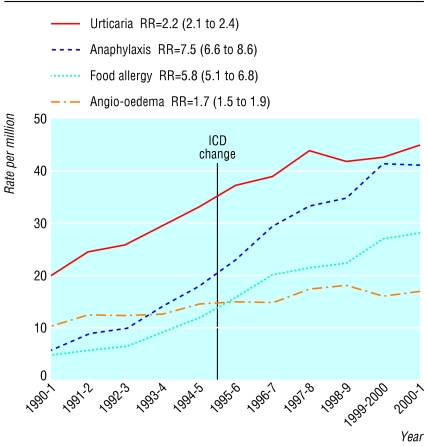Epidemiological studies indicate that the prevalence of allergic disorders such as allergic rhinitis, asthma, and eczema have increased during recent decades in many Western countries.1 Although anecdotal reports suggest that the prevalence of systemic allergic conditions may also be changing, only limited evidence exists to support this assertion.2 We report on trends in admissions for anaphylaxis, angio-oedema, food allergy, and urticaria, analysed by using national hospital discharge statistics from 1990-1 to 2000-1.
Methods and results
We obtained hospital admissions data from the hospital episode statistics system.3 This database records episodes of care after admission to hospital and assigns a primary diagnosis on discharge based on the international classification of diseases (ICD).4 Data are available by financial year (1 April-31 March). Diagnoses were classified using the ninth revision (ICD-9) up to March 1995 and using the tenth revision (ICD-10) thereafter.
We identified admissions for anaphylaxis, angio-oedema, food allergy, and urticaria (ICD-9 codes: 995.0, 999.4, 995.1, 693.1, 708; ICD-10 codes: T78.0, T78.2, T80.5, T88.6, T78.3, L27.2, T78.1, L50). We calculated age and sex standardised admission rates and used rate ratios to quantify the changes over the 11 year period. We tested for time trend by fitting simple linear regression models to the standardised rates for each condition.
A total of 49 300 admissions for systemic allergic conditions occurred during the 11 year study period (urticaria: 19 250; anaphylaxis: 13 230; food allergy: 8690; angio-oedema: 8180). Total admissions for these four disorders increased from 1960 admissions in 1990-1 (0.02% of all admissions) to 6752 in 2000-1 (0.06%) (figure).
Figure 1.
Trends in age and sex standardised admission rates for anaphylaxis, angio-oedema, food allergy, and urticaria, with rate ratios (RR) and 95% confidence intervals, England 1990-2001
The largest increases in rates have been for anaphylaxis and food allergy. Anaphylaxis rates rose from 6 to 41 per million between 1990-1 and 2000-1, and food allergy rates rose from 5 to 28 per million over this period. The greatest number of admissions was for urticaria, although increases in admission rates for this condition have been less rapid, doubling from 20 to 43 per million. Admissions for angio-oedema have risen more modestly from 10 to 17 per million. All trends were highly significant (P < 0.0001).
Comment
Highly significant increases in admissions for systemic allergic diseases (anaphylaxis, angio-oedema, food allergy, and urticaria) occurred in England between 1990-1 and 2000-1. This almost certainly reflects an increase in incidence.
Trends in admissions can reflect changes in health care; in disease labelling, coding, or recording; and in the underlying epidemiology of the condition. We were unable to assess the impact, if any, of changes in health seeking behaviour but believe it is a minimal source of bias in people admitted to hospital. Changes due to greater public awareness of the risks of allergic reactions or to better treatment cannot be ruled out, however; an eightfold increase in community prescriptions for allergic emergencies (adrenaline, BNF category 3.4.3) in this period may be evidence of this.5
We were unable to assess the accuracy of diagnoses. It seems likely, however, that any misclassification would have led to diagnostic transfer within the four disease areas under study. ICD-10 came into operation half way through the study period, but trends were broadly similar in the period 1990-1 to 1994-5 and 1995-6 to 2000-1 and showed little evidence of step changes.
A changing threshold of admissions is unlikely to have accounted for the findings observed, as no major new guidelines or recommendations for the management of allergic conditions were produced during this period. These increases could be caused by increasing exposure to environmental risk factors (such as peanuts and other foods or latex), to an increased susceptibility in the population to these allergens, or to a combination of these factors.
Contributors: All four authors were involved in drafting the study protocol, interpreting the results, and writing the paper. RG analysed the data and is the study's guarantor.
Funding: Project grant from the British Society of Allergy and Clinical Immunology. RG is supported by the Lung and Asthma Information Agency (funded by National Asthma Campaign, British Lung Foundation, and British Thoracic Society). A NHS/PPP primary care award supports AS.
Competing interests: None declared.
Ethical approval: Not needed.
References
- 1.European Allergy White Paper: allergic diseases as a public health problem. Braine-l'Alleud: UCB Institute of Allergy, 1997.
- 2.Sheikh A, Alves B. Hospital admissions for acute anaphylaxis: time trend study. BMJ 2000;320: 1441. [DOI] [PMC free article] [PubMed] [Google Scholar]
- 3.Department of Health. Hospital episode statistics (Volume 1). London: HMSO, 1991.
- 4.World Health Organization. International classification of diseases: manual of the international statistical classification of diseases, injuries, and causes of death. London: HMSO, 1977.
- 5.Department of Health. Prescription cost analysis. www.doh.gov.uk/prescriptionstatistics/index.htm (accessed 14 July 2003).



